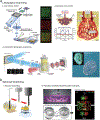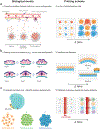Bioprinting for the Biologist
- PMID: 33417859
- PMCID: PMC10335003
- DOI: 10.1016/j.cell.2020.12.002
Bioprinting for the Biologist
Abstract
Building tissues from scratch to explore entirely new cell configurations could revolutionize fundamental understanding in biology. Bioprinting is an emerging technology to do this. Although typically applied to engineer tissues for therapeutic tissue repair or drug screening, there are many opportunities for bioprinting within biology, such as for exploring cellular crosstalk or cellular morphogenesis. The overall goals of this Primer are to provide an overview of bioprinting with the biologist in mind, outline the steps in extrusion bioprinting (the most widely used and accessible technology), and discuss alternative bioprinting technologies and future opportunities for bioprinting in biology.
Copyright © 2020 Elsevier Inc. All rights reserved.
Figures





References
-
- Ahlfeld T, Doberenz F, Kilian D, Vater C, Korn P, Lauer G, Lode A, and Gelinsky M (2018). Bioprinting of mineralized constructs utilizing multichannel plotting of a self-setting calcium phosphate cement and a cell-laden bioink. Biofabrication 10, 045002. - PubMed
-
- Ahlfeld T, Guduric V, Duin S, Akkineni AR, Schütz K, Kilian D, Emmermacher J, Cubo-Mateo N, Dani S, Witzleben M.v., et al. (2020). Methylcellulose – a versatile printing material that enables biofabrication of tissue equivalents with high shape fidelity. Biomaterials science 8, 2102–2110. - PubMed
Publication types
MeSH terms
Grants and funding
LinkOut - more resources
Full Text Sources
Other Literature Sources

